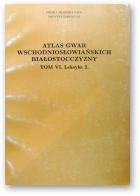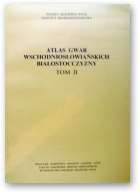- Home Page
- What’s New
- Books
- Audiobooks
- Periodicals
- Radio auditions
- Music
- Video
- Plans
- BHA’s Catalog
- EEDC’s Catalog
- Shop
- Skaryna’s Catalog
- MiOKB’s Catalog
- Private Catalog
- Belarusian Authors
- Belarusian publishers
- Publishing series
- Belarusan Emigration Collections
- Aphorisms
- Our banners
- About Us
- Partners
- Search/ Catalog
- News Archive

|

|
Atlas gwar wschodniosłowiańskich Białostocczyzny
Volume: VI. Leksyka 2.
Publication Place: Warszawa
Publication Date: 1996
Editor: Martyniakowa Irena
Publisher: Polska Akademia Nauk. Instytut Sławistyki
Publishing/ Printing House: SOW
Sizes: 296с., іл., 31см
ISBN: 83-04-00456-9 całość, 83-86619-16-3 t. VI
ISSN: 0208-4058
Category: Ethnography; History; Culture; Methodological Literature; Society; Sources
Book Collection: MiOKB — the library of the Belarusian Culture Community and Museum, ul. 3 Maja 42, Hajnówka (hardcopy); BTH — the library of the Belarusian Historical Association, ul. Proletariacka 11, Białystok (hardcopy)
Copy Numbers: BTH — [910]; MiOKB — [10425]
The Atlas of East Slavic Dialects Spoken in the Bialystok Area This is arguably the most complete and accurate localization of Belarusian, Ukrainian, Russian and Polish dialects that can be found in the Bialystok area. It is possible to trace a dialect to one language or another and identify the ethnic roots of villagers by following people's migration and examining the influence of dialects on languages spoken in the area. The work includes a phonetic analysis of words, examples of different words denoting the same things in various villages. The atlas is an excellent aid for those studying Podlasie language diversity and connections among cultures. It is recommended for researchers, students and other persons interested in the subject.
Worth reading:
Atlas gwar wschodniosłowiańskich Białostocczy...
The Atlas of East Slavic Dialects Spoken in the Bialystok Area This is arguably the most complete and accurate localization of Belarusian, Ukrainian, Russian and Polish dialects that can be found in the Bialystok area. It is possible to trace a dialect to one language or another and identify the ethnic roots of villagers by following people's migration and examining the influence of dialects on languages spoken in the area. The work ... More »







